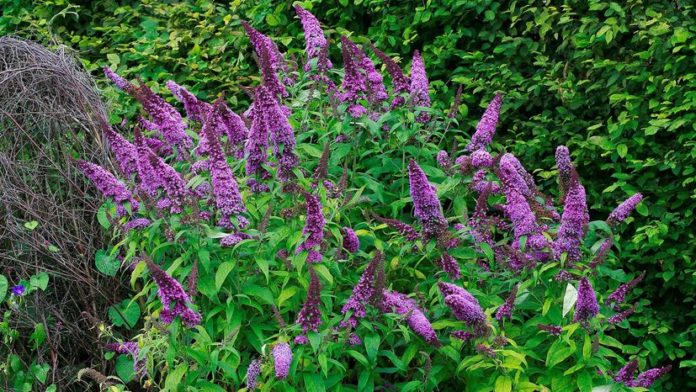 “Butterfly bushes (Buddleja davidii), such as this "Peakeep" variety, are prolific bloomers, providing color to the garden and food for both butterflies and hummingbirds. Paroli Galperti/REDA&CO/Universal Images Group/Getty Images
“Butterfly bushes (Buddleja davidii), such as this "Peakeep" variety, are prolific bloomers, providing color to the garden and food for both butterflies and hummingbirds. Paroli Galperti/REDA&CO/Universal Images Group/Getty Images
The butterfly bush (Buddleia davidii) is difficult to beat when it comes to sheer flower power. These sun-loving plants not only are some of the longest-blooming shrubs you can find, but they also are available in a rich array of summer-ready colors, bloom continuously through fall, and of course, attract butterflies and hummingbirds galore. Wondering why you should grow a butterfly bush? Here are five reasons they’re so great.
1. They Really Do Attract Butterflies
According to Patricia Collins, retired director of gardens for Callaway Gardens in Pine Mountain, Ga., the blooming shrub’s large, fragrant and multicolored blossoms not only will attract a large number of butterflies to your garden, but also will draw other pollinators as well. The reason they draw butterflies is because the flowers are high in nectar, adds Raleigh Wasser, a horticulture manager for Atlanta Botanical Garden in an email interview. "They’re not a ‘host plant’ for butterflies, however, in that they don’t support butterfly reproduction and lifecycle," she says. "Caterpillars don’t feed on butterfly bushes. Instead, they only provide nectar to adult butterflies."
2. They Are Super Easy and Require Minimal Care
"They are considered drought-tolerant, but theyrespond to good watering practices," says Collins via email. "To keep the plant blooming more, you can ‘deadhead’ the old bloom spikes — which means you can remove the old bloom spikes that have finished blooming and are beginning to go to seed. In the Southeastern U.S., they bloom most of the summer. They overwinter, and can be pruned in the winter since they bloom on the current season’s growth. Unless you are growing a tropical variety, the ones you purchase in your local nursery or garden center are perennial, and in the Southeastern U.S., will come back easily every year. They are hardy to Zone 5, so that includes a lot of the rest of the U.S. as well." A tip from Collins: It is best to grow butterfly bush in good gardening soil (you can modify heavy clay soils with good compost to ensure good drainage or sandy soils with compost to ensure good nutrition).
"They are seemingly impervious to challenging environments, like urban settings, and do well despite pollution, drought stress and insect pressure," adds Wasser.
 “A monarch butterfly (Danaus plexippus) takes a sip of nectar from the blossom of a butterfly bush. MyLoupe/UIG/Getty Images
“A monarch butterfly (Danaus plexippus) takes a sip of nectar from the blossom of a butterfly bush. MyLoupe/UIG/Getty Images
3. There Are Many Different Varieties and Colors
There are tons of colors and sizes on the market. According to Collins, some butterfly bushes are large shrubs and some are smaller dwarf shrubs (3 feet, or 0.9 meters, tall or so), and they can stand alone in your landscape or you can incorporate them into your flower beds. "The flowers are small, but grow in spikey fluorescents," she says. As for the colors: The blooms are mostly shades of blue, purple and lavender, but they come in white, pink and yellow as well. Butterflies seem to prefer the mauve of the species, according to The Old Farmer’s Almanac.
4. The More Sun, the More Blooms
"Butterfly bushes do best in full sun — or as much sun as you can provide," says Collins. "They don’t do well in full shade and need well-drained soil.Don’t plant butterfly bush in a shaded, boggy area." Adds Wasser: "When transplanting the plant to a pot or hole, make sure not to plant the roots any deeper than how they were in the corresponding pot. This is to avoid planting too deep and creating susceptibility to overwatering." Other tips from Wasser: Water when the soil is dry, and each winter (late winter), cut back canes to a few inches above ground. The canes that emerge will be the ones bearing flowers. Also, fertilize butterfly bushes in early spring and early fall with a balanced granular fertilizer, rich in natural and organic nutrients.
5. They Make Great Cut Flower Arrangements
"You can cut them any time while the plant is in bloom, but it’s best to cut the flowers in the morning when they are at their freshest. Once cut, place the flowers in water as soon as possible," says Wasser.
Now That’s Interesting
The butterfly bush can have invasive issues. "This is a problem when they out-compete other wanted plants and can become a noxious weed," says Wasser. They’re even on invasive plant watch lists or banned in some states. But many breeders are working on non-invasive and seedless varieties to avoid the issue altogether. Proven Winners, for instance, works with renowned plant breeder Dr. Dennis Werner of North Carolina State University to introduce seedless and non-invasive varieties, such as the Lo & Behold series and the "Miss" varieties.








































